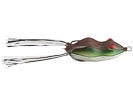Fishing Frogs, Toads, and Rats

Every bass angler knows that bass are equal opportunity eaters. Anything that swims, crawls, slithers, hops, or flies is on the menu for an aggressive fish. Most lures on the market focus on two primary food sources for bass; shad and other forage fish or crawfish and worms, although many anglers consider worms a crawfish imitation. Our ability to imitate more of the food sources that bass eat will give us more opportunities to catch more fish in more conditions, especially when the bass are not concentrating on shad or crawfish. Forage species other than shad and crawfish are found with far more frequency along the shoreline than in open or deep water. Some of these species can include frogs, snakes, birds, dragonflies, voles, mice, rats, young muskrats, baby ducks, and more. These species are aware of the danger of getting too close to open, predator infested water and will stay where they consider themselves safe; in the cover along the shoreline, in overhanging vegetation, and on top of thick mats of grass.
Our challenge is to get a lure into the type of cover these food sources inhabit without snagging every branch and stem of grass. The lures that can do this do exist and have become increasingly sophisticated over the past few years, resulting in lures that function exceptionally well in getting big bass out of thick, heavy cover. Depending on the section of the country you're from, this class of baits is known as rats, frogs, mice, and toads, among others. For simplicity, we'll call them frogs in this discussion.
The distinctive feature of the lures in this class is that the hooks are weedless and there are no protrusions or sharp angles that can pick up vegetation. They are also almost exclusively soft and most are hollow plastic. The idea behind the development of the frog lure is to enable anglers to put a lure into areas where an exposed hook will either hang up or pick up aquatic vegetation and drag it along, which will make a hungry bass shy away.

Using the frog lures is pretty easy. Cast it out on the grass and hop it back to the boat. Hooking and landing the big bass that often inhabit this water can be challenging. Typically, experienced frog anglers will use heavy line and fairly stout rods to get these fish. Monofilament lines in the 20-30 pound class are common, and braided superlines in the 50-80 pound class have gained immense popularity in the past few years. Super braids have the ability to cut through the grass more easily than monofilaments and they give you a great advantage in hooksetting power, especially on a long cast. Some anglers prefer low and medium gear ratio reels, like 5:1, for the cranking power needed to winch these fish out of the salad. Others like higher speed reels so they can keep the fish moving toward them when they pull them out on top of the grass. Rods are generally long, from 7-8 feet with a relatively light tip and lots of backbone. The light tip is needed for long accurate casts and the stiff mid and butt sections will set the hook and move the fish. The rod manufacturers G. Loomis and Lamiglas have produced rods that were designed and engineered specifically for fishing frogs and rats and have the action and power necessary to hook and land more frog fish. These rods were designed with input from some of the biggest names in the sport today; Bobby Barrack, Skeet Reese, Robert Lee, and Ish Monroe among others. These guys know what it takes to consistently put frog fish in the boat and you'll benefit from their experience.
Typical frog water would be a large grassy area, especially with moss or 'cheese' growing on top. Other good water would be sparse grass, pads, and the backs of coves where sticks and other debris have accumulated, as well as under overhanging trees. Areas with emergent vegetation and flooded brush and timber can also be very good if there is enough water. There should be sufficient depth of water under the cover and/or close, easy access to deep water so fish will feel confident enough to get under the protective covering. Most anglers wait until the hottest days of summer, when bass will be looking for the cooler, shaded, oxygenated water in the mats, but bass can and will be in these areas at any time of the year, depending on your latitude. Don't neglect the opportunity! You may be surprised, even in the late fall, early spring or in the winter where the water doesn't freeze up. It seems like some bass are always in shallow water, and they are always looking for cover and a meal.
When you've located some good looking frog water and you have the appropriate rod, reel and frog combo, then its time to start having some fun! The most common creature on top of these mats along the shoreline are frogs. Since your offering is much smaller than the big bullfrogs that live here, you'll want to thoroughly pick apart the mat and get your lure over any area that may hold fish. Some of these more productive areas would include any sticks or emergent vegetation that would indicate additional structure beneath the mat, channels, dropoffs, and rocks. Many of these spots can be located by observing the bank and extrapolating what's out in the water. Pay special attention to openings and thin spots since bass that are actively feeding will use these areas to ambush unwary frogs, birds, and other mat denizens.
When casting the frog, sometimes the best effect is to cause the frog to slap down hard on the mat, like a frog jumping off the bank. Sometimes you'll find it better to cast on the bank and ease the frog onto the mat. This technique is especially effective when the bass are right up on the bank and the slap may spook them. Other times you'll get an instant reaction strike as soon as the frog touches down. When the frog is on the mat your purpose will be to attract attention to your offering. On thin mats and in pads and sparse grass your frog and your retrieve will be enough to attract a fish. On thicker mats, you may need to add some weight to the frog. A couple of small weights shoved inside or some lead wire wrapped around the hooks should do the trick. Take care not to pack too much stuff into the bait since it will pile up at the tail end and may hinder your hookset if the body of the bait won't collapse to expose the hook points. Observe how frogs move, most often with fast short hops and long pauses, and imitate this natural motion. Frogs are more apt to pause on a pad or other floating debris than just stopping in open water where they know they are vulnerable, so try to imitate that behavior as well.
When fishing a break or opening in the mat, or when coming to the edge, be especially prepared to get bit since this is where the bass will see your bait most easily and can get at it without getting a mouthful of grass. Hop your frog near the edge of the hole and slowly twitch it forward and pause it on the edge. Playing with the family cat can teach us a lot about bass. How many times have you seen the cat watching a toy just sitting motionless, getting more and agitated until just the first twitch makes the cat explode? Bass are the same kind of predator; something that has stopped moving will draw more and more attention until the first twitch will make them eat. Your frog stopped at the very edge of a mat looking like it might want to jump in will keep a bass fixated until you twitch it in, and then hang on! Holes, edges, and thin spots are not the only places where your frog will be attacked. You will have fish breaking through thick stuff trying to get at your frog. Sometimes all they'll be able to do is knock it several feet into the air, but if they do get it you'll be glad you spooled up with heavy line on a stout rod.
One of the tricks to learn when frog fishing is the hookset. You may be all keyed up waiting for the explosion and pull the trigger right away, but all you'll get is your frog flying back in your face. When the bass eats, wait a second or two before setting the hook to ensure the fish has the bait. This way, your hooks will stick fish instead of nothing. Many anglers will wait until they feel pressure on their rods before setting. Experiment to see what works best for you, but pause before you set the hook and if you continually miss fish, pause a little longer. Another reason for missing strikes is as simple as dull hooks. Also, be sure to check every once in a while to make sure the hook point has not penetrated the body of the lure, where it won't do you any good. When you do set, set hard and try to get the fish turned toward you. If you can pull him back out the same hole he created when he bit you've got a good chance of landing him. If the fish turns on you and starts swimming around under the mat, tying up bales of grass, you'll have a much harder time. Be patient and keep pressure on the fish like you would if you were wrapped around a stick or brush in other situations and he may back himself out. The big double hooks found on most frogs hold on pretty well, but as we know, bass will always find a way to get off!
Color selection for frog baits is a subject of debate among experienced anglers. Since the frog is often on top of vegetation and therefore almost invisible, some anglers claim color doesn't make much difference. However, as we have seen, bass often lurk around the edges, and they may get a good look at your frog before committing to it. Straight black and plain white are the most common frog colors, and by far our best sellers. Brown, green, and other natural colors, as well as chartreuse, come along behind black and white, with other colors bringing up the rear. More and more natural looking finishes have been gaining popularity and seem to be catching more fish, and all major manufacturers have natural patterns currently on the market or planned for introduction. Since some frogs are supposed to imitate birds that get too close to hungry bass, the black and red patterns are supposed to imitate red-winged blackbirds, the black and yellow the yellowheaded blackbirds, and the sparrow pattern is self explanatory.
Another style of baits that falls into this genre are the soft plastic weedless walking baits on the market such as the Weed Demon and the exciting ZZ Walker. These lures will walk the dog like a Spook or Sammy but are weedless and can be used in areas you wouldn't dare throw a Spook. Prime locations for using these lures would be in sparse grass, under overhanging vegetation, in flooded timber and brush, or across mats and pads with lots of open water. These lures, especially the ZZ Walker, start walking almost instantly, so they will be effective even in a small patch of open water. They can be hopped over mats like a regular frog and walked in open areas, making them twice as effective.
There are some modifications that can be made to change your frog and make it more effective in certain situations. As we have seen, weight can be added so the bait will make a greater impression on the surface, and the noise from rattling weights will attract even more attention. Lure marking pens can add more realistic color patterns, and a white bait could be considered a fresh canvas waiting for you to create a masterpiece. Some anglers will replace the round rubber filament legs with plastic worms. This will enable you to create a bait up to a foot long with more weight and action. The hooks are also replaceable, and ultra-sharp replacement hooks are available from Gamakatsu and Owner. The Gamakatsu Wide Gap Frog Hooks can really help your hookup ratio since the soft plastic body of the frog will be able to depress further, exposing more of the hook and allowing better and deeper penetration. Whatever you choose to do to modify your frogs be careful not to raise the center of gravity or your bait will land and hop upside down!
Bass in some bodies of water seem to respond to plastic frogs and rats more than others and some days are better than others, so if the fish don't eat your offering today in one lake don't give up, try it again somewhere else. Once you start catching fish on the frog, you'll look forward to frog fishing every year.







